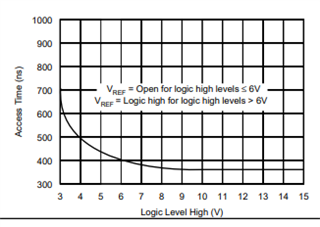Other Parts Discussed in Thread: SN74LXCH8T245
Tool/software:
Hi, I've got 2 MPC506 devices in parallel and I control the address bits together and the enables opposite using 5V logic levels to sequence through 32 analog input channels. I power the device with +/-13V and 5V on VRef. I see my system +13V current and -13V current change significantly every 4 addresses on the muxes. The pattern of current increase and decrease is the same as I sequence through the first mux and then it repeats for the second mux. All my analog inputs are driven and are within +/-5V range. I can change them or set them to zero and it doesn't have a correlation with this current draw. From lowest to highest current draw, the change is about 20mA which is well above the rating for the mux and we do see heating on the chips. The mux output is connected to an op-amp and the output steps around from channel to channel as expected and looks clean. During normal operation I step though the channels at 32ms per channel and there are no slew rate or settling issues.
Any help is appreciated. If you have any ideas why this current is changing so significantly, I'd appreciate hearing about them! I can send more design details, if needed.
Thanks,
Ryan



